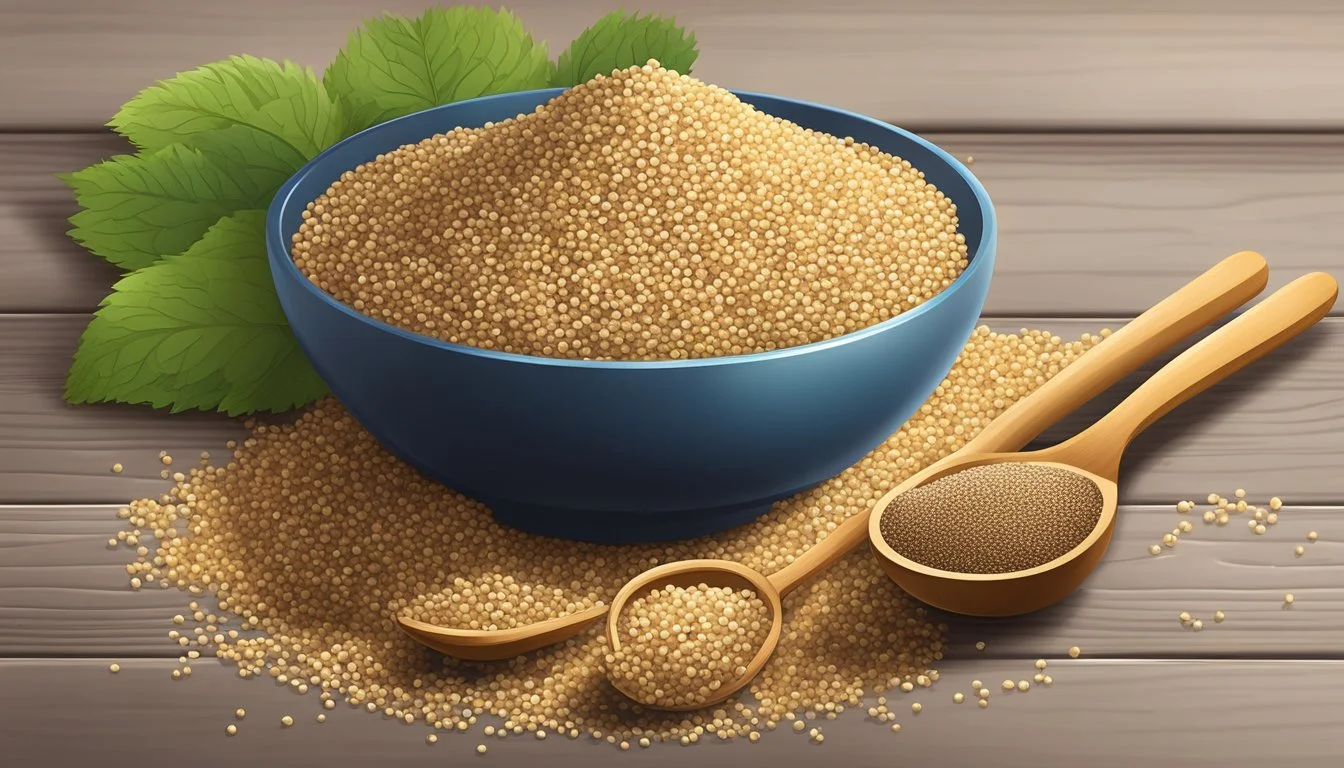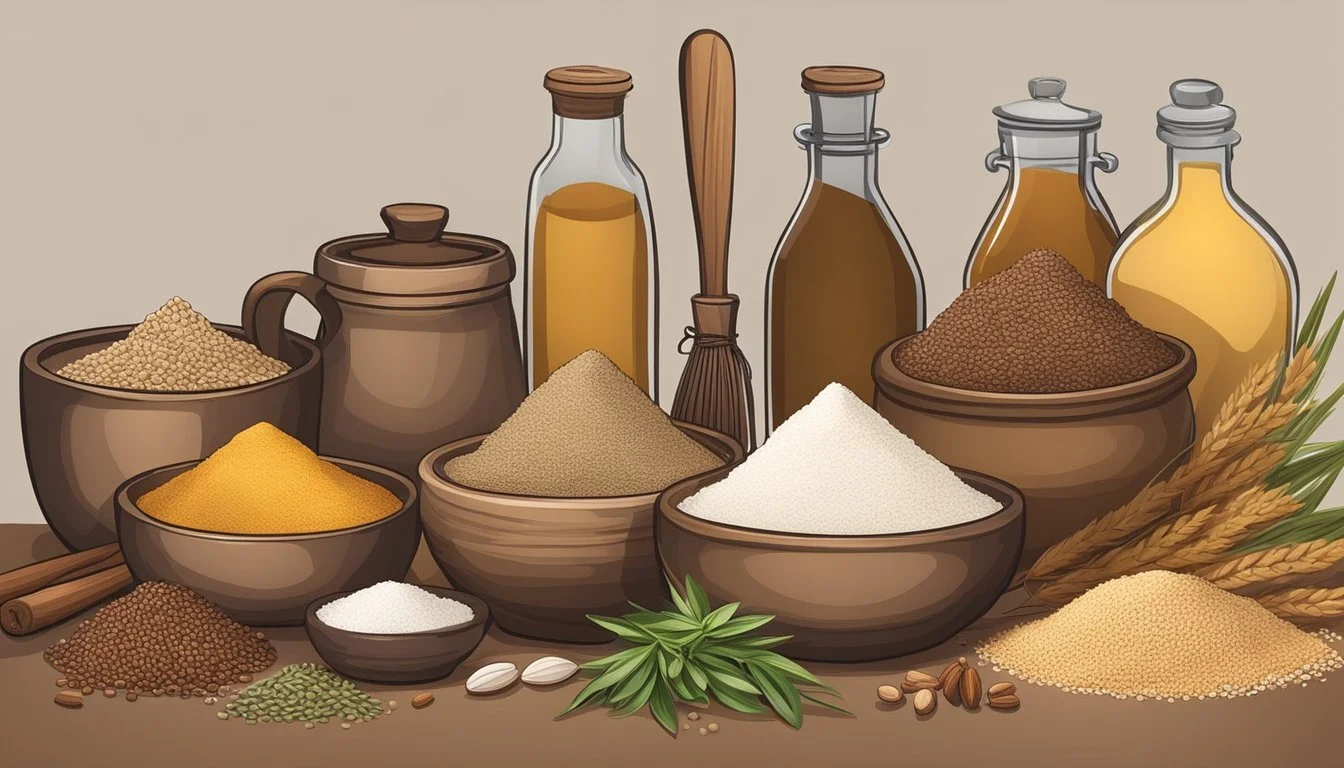Teff Substitutes
Top Alternatives for Your Gluten-Free Baking
Teff flour, an ancient grain from Ethiopia, has been a staple food for centuries, thanks to its impressive nutritional profile that includes high fiber, protein, and essential minerals like iron and magnesium. Recognized for its small size but significant health benefits, teff is traditionally used to make injera, a spongy sourdough flatbread that accompanies many Ethiopian meals. The grain's versatility and rich, nutty flavor have also made it a favored ingredient in various gluten-free recipes.
However, teff can sometimes be difficult to find in regular grocery stores, and for those looking to explore different flavors or textures, there are several suitable substitutes. Grains like quinoa offer a similar nutritional profile and are more widely available. Flour alternatives such as almond flour and buckwheat flour could be used to achieve a comparable consistency and richness in dishes, while contributing their unique taste characteristics. Each substitute brings its distinct qualities to recipes, allowing for a range of culinary experimentation.
Nutritional Profile of Teff
Teff is recognized for its impressive nutritional qualities, especially as it relates to its content of protein, fiber, and essential minerals. It stands as a mighty grain within the category of ancient grains, noted for providing a robust profile that supports a balanced diet.
Fiber: Teff is a rich source of dietary fiber, which is crucial for digestive health. It aids in maintaining regular bowel movements and can contribute to satiety.
Protein: The grain provides a substantial amount of plant-based protein, which is important for muscle repair, immune function, and overall health.
Essential Minerals: Teff's mineral composition is particularly noteworthy. It is a powerhouse of iron, which is key for blood health, and magnesium, which plays a role in over 300 biochemical reactions in the body.
Here's a breakdown of the key nutrients per cup of cooked teff:
Nutrient Amount Calories 255 Protein 10 grams Fiber 5 grams Fat 1.6 grams Iron 4.98 mg Magnesium 126 mg Calcium 123 mg Zinc 2.8 mg Phosphorus 0.8 mg B Vitamins Present
Calcium: Unique among grains, teff offers a noteworthy calcium content, which is vital for bone health.
Vitamins and Minerals: Besides the minerals listed, teff contains a spectrum of vitamins, particularly B vitamins, which are essential for energy metabolism and cognitive function. Phosphorus and zinc, also present in teff, contribute to cellular repair and immune defense.
Teff's nutritional profile makes it a suitable component of various diets, catering to the needs of individuals seeking nutrients often found in meat and dairy products, making it an integral part of vegetarian and vegan diets.
Culinary Applications of Teff
Teff, a tiny grain hailing from Ethiopia, is a nutritional powerhouse and a staple in various culinary traditions. Its application in the kitchen is diverse, spanning from traditional Ethiopian dishes to contemporary global cuisine.
Ethiopian Cuisine: Teff's most famous use is in the form of injera, a spongy, fermented flatbread that is at the heart of Ethiopian dining. It accompanies nearly every meal, serving not just as a food item but also as an eating utensil.
Baking and Flatbreads: Apart from injera, teff flour is an excellent ingredient for a variety of baked goods. It imparts a nutty flavor to breads and cakes, and due to its binding properties, it is often used in gluten-free recipes. Teff flour can also be used to make other flatbreads, adding a twist to traditional recipes.
Porridge: For breakfast, teff grains can be cooked into a porridge, offering a high-fiber, protein-rich start to the day. It can be customized with sweet or savory toppings according to preference.
Sauces, Soups, and Stews: Teff grain or flour can thicken sauces, soups, and stews, contributing both a subtle flavor and a nutritional boost.
Pancakes: Those seeking alternative pancake recipes might use teff to create fluffy and nutrient-dense pancakes, suitable for those who follow a gluten-free diet.
In cooking, chefs appreciate teff for both its versatility and its rich nutritional profile, including its high levels of calcium, iron, and protein. Its subtle nutty flavor complements a range of ingredients, making it a favored grain for chefs looking to craft both traditional and innovative dishes.
Common Teff Substitutes
Teff flour, an ancient grain from Ethiopia, is recognized for its high nutritional value. It's a staple for those with gluten sensitivities or celiac disease, due to its gluten-free property. However, teff can be expensive or hard to find. There are several substitutes that maintain a healthy profile and are suitable for gluten-free baking.
Quinoa Flour: Quinoa is an excellent alternative owing to its similar nutritional benefits. It's a complete protein and rich in fiber and minerals.
Rice Flour: Particularly brown rice flour, offers a neutral-tasting alternative, high in beneficial nutrients.
Gluten-Free Flours:
Buckwheat Flour: Despite its name, buckwheat is gluten-free and imparts a rich, earthy flavor.
Sorghum Flour: This flour is a popular gluten-free option with a texture close to traditional wheat flour.
Millet Flour: An easily digestible grain that gives a light, delicate texture in baked goods.
Almond Flour: Rich in protein and healthy fats, providing a moist texture and nutty flavor.
Tapioca Flour: Derived from cassava roots, it gives a chewy texture and is great for thickening.
Oat Flour: Oats are naturally gluten-free, but one should ensure they are processed in a gluten-free facility to avoid contamination.
Other Substitutes:
Coconut Flour: Requires more liquid than teff flour due to its high absorbency.
Amaranth Flour: A less common alternative known for its nutty flavor and nutrient richness.
Corn Flour and Potato Starch: These can be used in combination with other flours to mimic teff's texture and nutritional profile.
Barley Flour: A substitute for those without gluten intolerance, providing a similar sweet and nutty flavor.
These substitutes allow individuals with allergies or gluten intolerance to enjoy a variety of foods without compromising on health or taste. When substituting for teff flour, ratios can vary, so adjustments may be needed to achieve the desired outcome in recipes.
Characteristics of Substitutes
When exploring substitutes for teff, it is crucial to evaluate how they compare in terms of gluten content, texture and flavor profile, baking properties, and nutritional value, as well as their suitability for specific dishes and general availability.
Gluten-Free Alternatives
Gluten-free alternatives are essential for those with celiac disease or gluten intolerance. Amaranth is a popular gluten-free grain, sharing a comparable nutty flavor and offering a similar protein and fiber content. Cornmeal and various gluten-free flours, which may include almond flour or coconut flour, provide alternatives while maintaining a gluten-free diet.
Flavor and Texture Comparisons
The texture and flavor of teff substitutes play a significant role in how they are received in recipes. Amaranth, with its similar nutty flavor, can replicate the mild taste of teff. Almond flour also offers a delicate nutty taste and a fine texture suitable for baked goods. Cornmeal, although with a different flavor profile, can create textures in dishes that require a grain with a heartier bite.
Baking Considerations
In gluten-free baking, substitutes like almond and coconut flour can replace teff, but proportions and additional ingredients like xanthan gum need adjustment to provide the right structure. Baking with these substitutes often requires more liquid, given their differing absorption rates compared to teff flour.
Cooking Behaviors
Teff's unique properties act as a thickening agent in soups and sauces. Alternatives like tapioca flour or cornmeal can also thicken effectively but might alter the texture or flavor. In cooking dishes like porridge or injera, substitutes need to behave similarly when mixed with liquids, heating evenly without clumping.
Nutritional Considerations
Nutritional value is vital in any teff substitute. Amaranth and almond flour boast high levels of protein content, vitamins, and minerals. The glycemic index of substitutes also matters, as teff is known for its lower glycemic load, beneficial for blood sugar control.
Usage in Specific Dishes
The substitute’s capacity to fulfill teff's role in dishes is important. For gluten-free bread and pancakes, the substitute should provide a similar consistency and nutritional value. Almond flour works well for those needing a gluten-free option for desserts, while cornmeal is suitable for breading in fried foods or to add texture to salads.
Cost and Availability Issues
Cost and availability influence the choice of a substitute. While teff might be expensive or hard to locate, substitutes like cornmeal and almond flour are generally more accessible. Considering these factors is key in finding a suitable alternative that also aligns with the user's budget and location constraints.
Health Considerations
When considering health aspects of teff substitutes, individuals should examine the nutritional profile of potential alternatives. Teff flour is known for its high fiber content, beneficial for digestion, and an excellent source of protein. Substitutes for teff should ideally maintain these health benefits, especially for those with specific dietary needs.
For individuals with celiac disease or gluten sensitivities, identifying a gluten-free alternative is critical. Teff is naturally gluten-free, making it a safe choice for these individuals. Substitutes like almond flour and amaranth offer gluten-free profiles and are, thus, suitable replacements for ensuring dietary adherence.
Almond flour, in particular, is praised for its rich content of healthy fats and fiber, while amaranth contributes a similar nutty flavor and provides a similar nutritional profile, including essential minerals such as iron and calcium. However, those with nut allergies should avoid almond flour and seek other alternatives.
Substitute Gluten-Free High in Fiber High in Protein Considerations Almond Flour Yes Yes Yes Nut Allergies Amaranth Yes Yes Moderate Widely Available
Some flour alternatives may have a higher or lower glycemic index than teff, which can be an important consideration for individuals managing blood sugar levels. Teff has a low glycemic index, beneficial for maintaining steady glucose levels. Those requiring a low glycemic option should verify the index of their chosen substitute.
It is imperative for individuals to carefully assess these health factors when selecting a substitute for teff flour to ensure their dietary needs are met without compromising their well-being.
Cultural and Regional Aspects
Teff, an ancient grain originating from Ethiopia and Eritrea, is deeply embedded in the cultural and culinary traditions of these East African countries. It serves as a staple food, revered for its nutritional benefits and culinary flexibility. In Ethiopia—often considered the cradle of teff—this grain assumes a role beyond mere sustenance; it is interwoven with national identity and cultural pride.
The grain's prominence is showcased in the form of injera, the ubiquitous Ethiopian flatbread. It is a cornerstone of Ethiopian cuisine, serving as both the plate and utensil for a variety of stews and dishes. Eritrea shares this tradition, highlighting teff's cross-border cultural significance.
Teff's role is so central that its absence on the daily menu is often associated with poverty. The societal value attached to teff is profound, with its cultivation and consumption tracing back thousands of years. As a result, finding substitutes within these regions requires careful consideration of both the cultural impact and dietary contributions. Below is a brief overview of the cultural importance of teff:
Ethiopia & Eritrea: Identifies teff as a cultural symbol, with injera being a daily staple.
Nutritional significance: Appreciated for its high mineral and protein content.
Economic impact: A key crop for both local economies and international exports.
Substituting teff in regions where it is a staple involves balancing respect for cultural traditions with the practicalities of nutrition and availability. Alternatives must be nutrient-dense to maintain dietary needs yet accessible to honor the socio-economic realities.
Environmental and Economic Impact
The environmental and economic impacts of substituting teff with other grains are significant and multifaceted, particularly in the context of sustainability and economic viability.
Sustainability of Grain Crops
Grain crops differ in their environmental footprint, with ancient grains like teff often being praised for their resilience in harsh conditions. For instance, teff's ability to thrive in diverse agro-ecological zones and its tolerance to extreme moisture conditions make it a sustainable choice, especially amid climatic uncertainties. However, when evaluating substitutes, the sustainability of each crop must be compared based on factors such as water usage, soil health, and carbon footprint.
Water Requirements: Teff requires less water than many other grains, making it more sustainable in arid regions.
Soil Health: As a whole grain, teff contributes to soil health by providing crop rotation options, reducing the need for fallow periods.
Economic Factors in Grain Production
The economic impact of substituting teff hinges on several factors including grain flour market prices, production costs, and availability. Teff, although often more expensive than more common grains, holds a unique place as a staple food which influences its economic value.
Market Prices: The shift from teff to less expensive grains could affect market prices and demand for grain flour.
Production Costs: Economies of scale can make widely produced grains cheaper to farm than niche crops like teff.
Availability: The supply of teff versus its substitutes affects its price stability and economic accessibility for consumers.
In this section, we have outlined how switching from teff to alternative grains impacts environmental aspects such as water use and soil health, and economic factors such as cost of production and market prices. These considerations are pivotal in assessing the viability of teff and its substitutes as staple foods globally.






